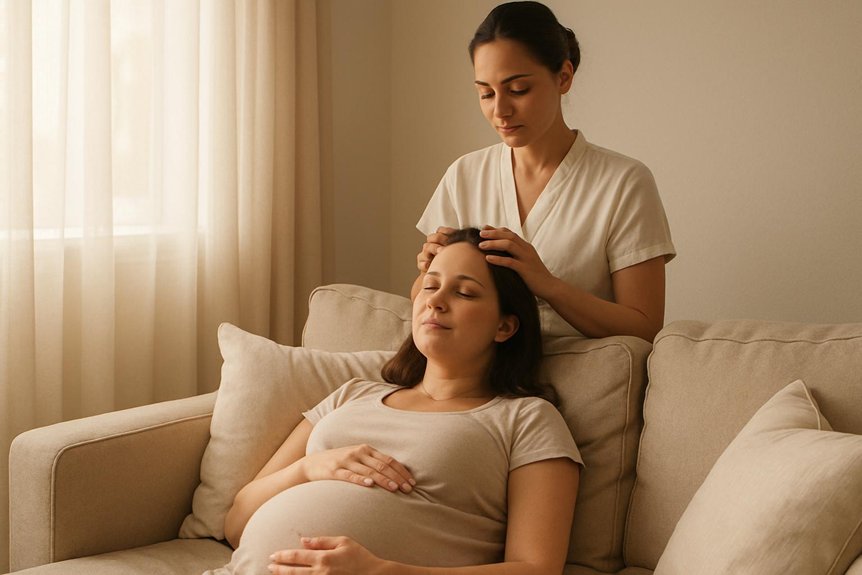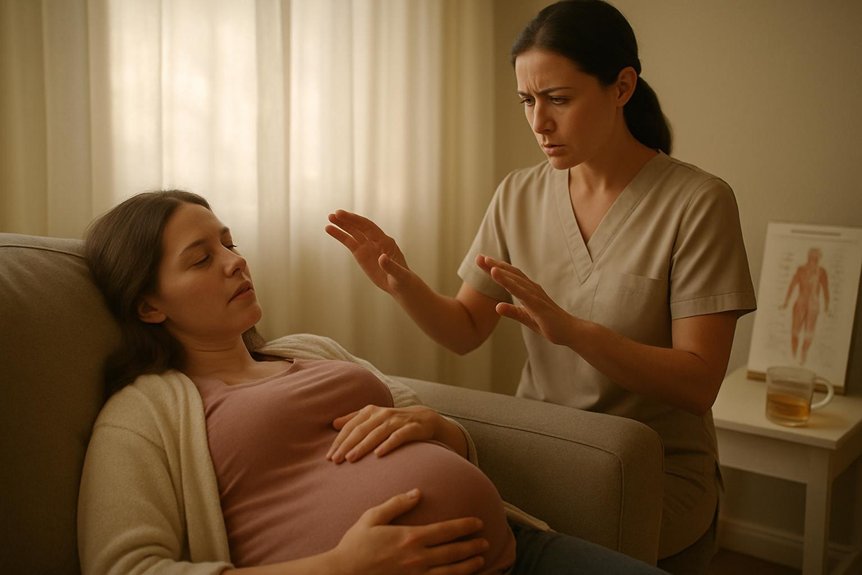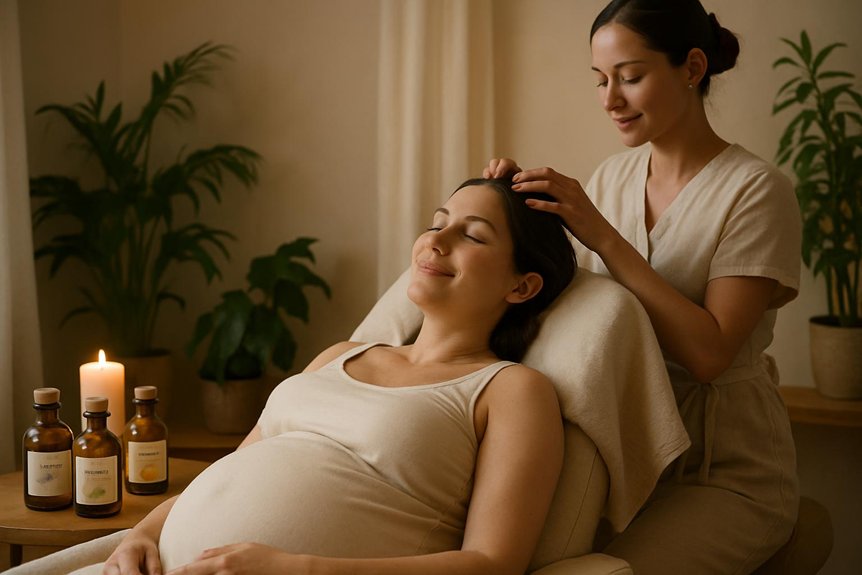Head massage in pregnancy is generally safe with trimester-appropriate adaptations and screening. Light-to-moderate pressure, side-lying or semi-reclined positioning, and neutral oils are recommended. Avoid or postpone if there are severe or sudden headaches, neurological signs, fever, illness, scalp infection, early pregnancy complications, or recent infection. Essential oils should be minimal or avoided unless approved. Stop and seek urgent care for visual changes, chest pain, swelling, or severe headache. Proper technique may ease tension and improve sleep, with further details available ahead.
Is Head Massage Safe During Pregnancy?

Head massage is generally considered safe in pregnancy when delivered by trained therapists who adapt techniques to gestational stage and maternal risk factors. Safety depends on clinical screening, positioning, pressure control, and product choice.
At Spa & Massage, therapists assess trimester, headache pattern, blood pressure, history of pre-eclampsia, vaginal bleeding, reduced fetal movements, and clotting risks.
During the first trimester, lighter touch and shorter sessions are preferred; supine time is limited later in pregnancy to avoid vena cava compression, with side-lying or supported seated positioning.
Friction over cervical paraspinals and scalp is moderated to reduce dizziness or nausea.
Neutral, hypoallergenic oils—or oil-free methods—are selected; potent essential oils are avoided unless specifically cleared.
Head massage may provide some of the benefits and techniques associated with deep tissue massage, though care is taken to keep pressure light during pregnancy.
Any sudden visual changes, severe headache, swelling, chest pain, or neurological symptoms prompt immediate medical referral.
Key Benefits of Head Massage for Expectant Mothers
When applied with light-to-moderate pressure and trimester-appropriate positioning, targeted scalp and neck techniques can reduce tension-type headaches. They do this by easing myofascial tightness and promoting cranial blood flow.
Evidence also links gentle head massage with improved sleep quality via parasympathetic activation and modest reductions in cortisol. Our therapists aim for these outcomes by using short, structured sessions.
From a risk perspective, brief treatments help calm stress and anxiety without overstimulation. At Spa & Massage, therapists avoid trigger points and contraindicated oils to maintain maternal and fetal safety.
Eases Tension Headaches
Although headache patterns vary in pregnancy, tension-type headaches are common and often linked to cervical muscle tightness, poor sleep, and stress.
Evidence suggests that gentle manual work to the scalp, suboccipitals, temples, and upper trapezius reduces pericranial muscle tenderness and modulates pain pathways. At Spa & Massage clinics in London, therapists use light-to-moderate pressure, slow effleurage, and targeted myofascial release around the neck base to decrease nociceptive input while avoiding trigger points that may provoke discomfort.
Risk management is central: therapists position clients in side-lying or semi-reclined postures, monitor blood pressure symptoms, and avoid excessive neck flexion, deep pressure, and stimulating essential oils. Jojoba or grapeseed oils are preferred for low fragrance and skin tolerance.
Clients are advised to hydrate, rise slowly post-session, and seek medical review for new, severe, or persistent headaches.
Improves Sleep Quality
By reducing pericranial tenderness and neck muscle hypertonicity linked to tension-type headaches, targeted scalp and neck work can also facilitate more consolidated sleep in pregnancy.
Evidence suggests that light-to-moderate pressure over the suboccipitals, temporalis, and upper trapezius may improve sleep continuity by decreasing nociceptive input and easing cervicogenic discomfort that disrupts nocturnal rest.
In our London clinics, therapists deliver pregnancy-safe sessions in a side-lying position with neutral cervical alignment, using unscented or mild hypoallergenic oils to avoid irritation or nausea.
Risk management remains central: no deep pressure at the anterior neck, no trigger-point holds that provoke dizziness, and careful monitoring for supine hypotensive symptoms.
Clients are advised to schedule earlier evening sessions, hydrate, and avoid stimulating oils.
Consistent weekly treatments can support steadier sleep architecture without pharmacologic aids.
Calms Stress and Anxiety
A targeted head massage can reduce pregnancy-related stress and anxiety through downregulation of sympathetic arousal and enhancement of parasympathetic tone. Evidence points to lowered heart rate, improved heart rate variability, and modest reductions in cortisol when light-to-moderate pressure is applied to the scalp, temples, neck, and upper shoulders.
At Spa & Massage clinics in London, therapists use slow, rhythmic effleurage, gentle circular kneading, and sustained occipital holds to cue relaxation without compressing the abdomen or provoking dizziness.
Risk considerations are central. Sessions avoid unsupported supine positioning after the first trimester; side-lying or semi-reclined setups are used.
Essential oils are optional and kept low concentration; stimulating oils are avoided. Clients with migraines, preeclampsia risk, or cervical instability receive adapted techniques, shorter durations, and ongoing monitoring.
When to Avoid or Postpone a Head Massage

Spa & Massage advises postponing head massage in the first trimester unless cleared by a midwife or GP, as a precaution during early embryonic development and while screening for complications.
Clients with active migraine or severe unexplained headache should seek medical assessment first, since pressure and sensory input may exacerbate symptoms or mask red flags.
Fever, systemic illness, or local scalp infection are also contraindications; therapy should resume only after recovery to reduce transmission risk and avoid stressing a compromised system.
First Trimester Caution
When is it safer to wait? In the first trimester, cautious timing matters. Nausea, fatigue, blood pressure variability, and heightened scent sensitivity can make head massage uncomfortable or destabilizing.
Evidence-informed practice prioritises minimal stimulation during weeks 4–12, especially if there is vaginal bleeding, cramping, a history of miscarriage, IVF pregnancy, or uncontrolled thyroid or blood pressure issues.
Any fever, infection, or new neurological symptoms warrants deferral and medical advice.
At Spa & Massage, therapists recommend postponing if morning sickness is active on the day, or if strong aromas trigger queasiness.
If proceeding, they use unscented or very mild oils, shorten sessions, keep pressure light, avoid acupressure points linked to uterine activity, and position semi-reclined.
Clients are encouraged to hydrate, eat lightly beforehand, and stop immediately if dizziness or nausea occurs.
Migraine or Severe Headache
Headache patterns in early pregnancy can shift, and those with active migraine or a severe, sudden-onset headache require caution before any head massage. A current migraine attack—especially with aura, neurological symptoms, or a “worst-ever” presentation—warrants medical assessment first.
Massage may amplify sensory overload, alter blood pressure, or provoke nausea. If red flags are present (thunderclap onset, visual changes, weakness, neck stiffness, or escalating pain despite rest), head massage should be postponed and urgent care sought.
From Spa & Massage’s clinical perspective, sessions resume only when symptoms settle and a clinician has ruled out concerning causes.
Our therapists adapt pressure, positioning, and duration, prioritising quiet rooms and minimal stimulation. Clients are encouraged to hydrate, track triggers, and book on headache-free days, with gentle scalp work introduced slowly if approved.
Fever, Illness, or Infection
Why postpone a head massage during pregnancy when fever or infection is present? Because systemic illness alters circulation, raises core temperature, and can increase maternal heart rate—factors that massage may amplify. Infections (viral, bacterial, or COVID‑like symptoms) also pose transmission risks to therapists and other clients.
Evidence-based guidance prioritises rest, hydration, and medical assessment when temperature exceeds 38°C, when there is persistent cough, sore throat, gastrointestinal symptoms, urinary symptoms, or flu-like malaise.
At Spa & Massage, therapists postpone treatments until the client is fever-free for 24–48 hours without antipyretics and symptoms are resolving.
If antibiotics are prescribed, sessions resume after at least 48 hours of tolerance and improvement.
When returning, lighter-pressure scalp work and neutral, hypoallergenic oils are used, with sessions shortened and close monitoring for fatigue or dizziness.
How We Adapt Head Massage Techniques in Our Clinics
Although relaxation is a key outcome, Spa & Massage standardises head massage for pregnancy around safety, positioning, and pressure control.
Therapists screen for trimester, headache red flags, dizziness, and pre-eclampsia symptoms, and they defer if fever, infection, or unexplained swelling is present.
Positioning prioritises left-side-lying or supported semi-recline to protect venous return and reduce reflux. Techniques focus on slow, rhythmic scalp effleurage, gentle circular friction at the temples and occiput, and light myofascial holds along the neck—avoiding sustained pressure, trigger-point aggression, and end-range cervical mobilisations.
Pressure is set to light–moderate, reassessed every few minutes using a pain scale and breath cues. Sessions are shorter when fatigue, insomnia, or nausea are active.
Hydration guidance and cautious, gradual rises reduce orthostatic symptoms.
Oils and Aromas Our Therapists Recommend in Pregnancy

For pregnancy head massage, Spa & Massage therapists prioritize neutral, hypoallergenic carrier oils and low-dose, pregnancy-appropriate aromas to minimize sensitization and nausea.
In our clinics, fractionated coconut, grapeseed, or jojoba are preferred for their light texture and low comedogenic profile. Essential oils, when requested, are limited to conservative dilutions (typically ≤0.5%) after a brief screening for allergies, trimester, and migraine history.
Clinically cautious options include lavender (true), Roman chamomile, and sweet orange—used sparingly to support comfort without overpowering scent.
Peppermint, rosemary, clary sage, and jasmine are avoided due to uterotonic or stimulant concerns.
Where aroma sensitivity is high, therapists default to unscented carrier oil or dry techniques.
Patch testing is offered, and oils are kept fresh, clearly labelled, and removed with warm towels to reduce residue and fragrance persistence.
What to Expect in a Pregnancy-Safe Head Massage Session
After selecting suitable carrier oils and any conservative aromas, the appointment proceeds with a brief clinical screening: gestational age, obstetric history, headache patterns, skin sensitivities, nausea, positional tolerance, and contraindications (e.g., preeclampsia, unexplained bleeding, fever, recent head or neck injury).
At Spa & Massage, therapists then position the client semi-reclined or side-lying with bolsters to protect venous return and airway comfort. Pressure is light-to-moderate, avoiding trigger points linked to cervical tension headaches if they provoke symptoms.
Techniques emphasise slow scalp effleurage, gentle circular friction along the temporalis and occipital base, and cautious neck mobilisations without end-range rotation. Duration is typically 20–30 minutes within a longer appointment, with pauses for feedback on dizziness, visual aura, or nausea.
Oils remain minimal to prevent slip risk. Post-session, therapists reassess vital signs and provide hydration guidance and red-flag advice.
Simple At-Home Scalp Massage Tips Between Appointments
Between appointments, brief self-administered scalp massage can support symptom control if performed conservatively and with attention to pregnancy-specific cautions.
Spa & Massage advises a seated, supported posture, keeping sessions to 3–5 minutes, once or twice daily.
Gentle fingertip circles along the hairline, temples, and occipital ridge can ease tension; pressure should remain light, avoiding any trigger-point intensity.
Slow strokes toward the crown may calm scalp tightness without provoking dizziness.
A small amount of neutral, unscented carrier oil is acceptable if skin tolerates it; in our clinics, therapists avoid strong essential oils during pregnancy and recommend patch testing first.
Hydration before and after is prudent.
If headache escalates, vision blurs, swelling increases, or nausea intensifies, stop and seek clinical guidance.
Consistency and restraint protect comfort between professional sessions.
Aftercare and Signs to Monitor Following a Head Massage
Simple home techniques complement professional care, but post-session management determines safety and symptom control in pregnancy.
At Spa & Massage, therapists advise slow progressions from lying to sitting, then standing, to prevent orthostatic dizziness.
Hydration supports circulatory changes and helps clear post-massage metabolites; a light snack stabilises glucose.
Fragrance-sensitive clients may request unscented or low-dose aromatherapy; our clinics use pregnancy-safe dilutions.
Monitor for red flags: persistent headache beyond 24 hours, visual changes, facial or hand swelling, calf pain, chest tightness, reduced foetal movement, vaginal bleeding, or fluid loss—seek urgent medical review.
Expected effects include mild scalp tenderness or transient fatigue; rest and warm showers usually ease these.
Re-book if sleep improves or tension reduces; postpone if cold, fever, new hypertension, or migraines escalate.
Conclusion
In summary, carefully conducted head massage can be a safe, soothing support in pregnancy when delivered with clinical caution and individualized adjustments. Gentle, graded pressure, prudent positioning, and pregnancy-safe products help reduce stress, stiffness, and sleep disturbance while minimizing risk. Clients should communicate symptoms, share history, and seek medical guidance for red flags. Sensible scheduling, symptom surveillance, and therapist specialization sustain safety. With measured methods and mindful monitoring, mothers may gain meaningful, evidence-aligned comfort while protecting maternal and fetal wellbeing.